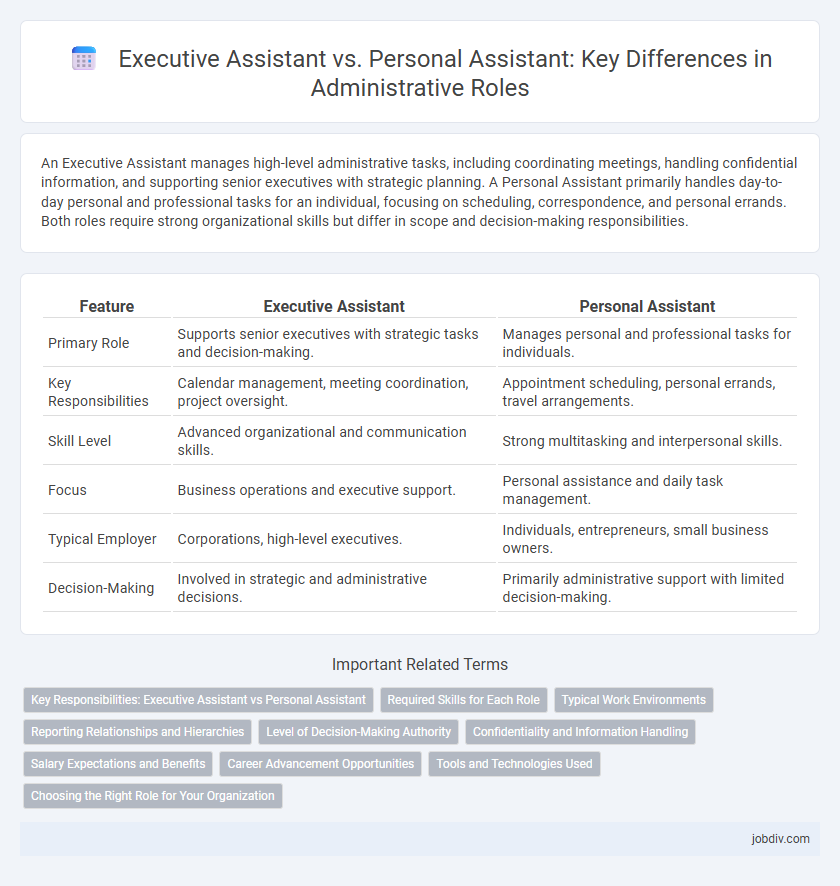An Executive Assistant manages high-level administrative tasks, including coordinating meetings, handling confidential information, and supporting senior executives with strategic planning. A Personal Assistant primarily handles day-to-day personal and professional tasks for an individual, focusing on scheduling, correspondence, and personal errands. Both roles require strong organizational skills but differ in scope and decision-making responsibilities.
Table of Comparison
| Feature | Executive Assistant | Personal Assistant |
|---|---|---|
| Primary Role | Supports senior executives with strategic tasks and decision-making. | Manages personal and professional tasks for individuals. |
| Key Responsibilities | Calendar management, meeting coordination, project oversight. | Appointment scheduling, personal errands, travel arrangements. |
| Skill Level | Advanced organizational and communication skills. | Strong multitasking and interpersonal skills. |
| Focus | Business operations and executive support. | Personal assistance and daily task management. |
| Typical Employer | Corporations, high-level executives. | Individuals, entrepreneurs, small business owners. |
| Decision-Making | Involved in strategic and administrative decisions. | Primarily administrative support with limited decision-making. |
Key Responsibilities: Executive Assistant vs Personal Assistant
Executive Assistants manage high-level administrative tasks such as scheduling meetings, preparing reports, and coordinating projects to support C-suite executives, emphasizing strategic involvement. Personal Assistants handle daily personal and professional tasks, including managing calendars, booking travel, and running errands, focusing primarily on relieving individual workload. Both roles require exceptional organizational skills but differ in scope and level of responsibility within corporate administration.
Required Skills for Each Role
Executive Assistants require advanced organizational skills, proficiency in project management software, and strong communication abilities to manage complex schedules and liaise with senior executives effectively. Personal Assistants must possess exceptional multitasking capabilities, confidentiality, and adaptability to handle both professional and personal tasks for their employers. Both roles demand time management expertise, discretion, and proficiency in office technology, but Executive Assistants often need higher-level strategic planning skills.
Typical Work Environments
Executive Assistants typically work in corporate offices, supporting high-level executives in dynamic, fast-paced business environments. Personal Assistants often operate in private settings, assisting individuals with both professional and personal tasks, including managing schedules, travel, and household affairs. The nature of their work environments reflects the scope of responsibilities, with Executive Assistants embedded within organizational structures and Personal Assistants providing more individualized support.
Reporting Relationships and Hierarchies
Executive Assistants typically report directly to senior executives such as CEOs or Vice Presidents, operating within higher organizational hierarchies and handling strategic tasks. Personal Assistants usually support individuals at various levels, including middle management or private persons, with a focus on managing daily schedules and personal errands. The reporting relationship of an Executive Assistant often involves cross-departmental coordination, whereas a Personal Assistant's role is more singularly focused on their employer's immediate needs.
Level of Decision-Making Authority
Executive Assistants typically possess a higher level of decision-making authority, often handling complex tasks, managing schedules, and making decisions in the absence of executives. Personal Assistants generally focus on day-to-day personal and administrative tasks, featuring limited decision-making powers mostly related to organizing and supporting. The distinction in authority reflects the scope of responsibilities, with Executive Assistants playing a more strategic role within organizational operations.
Confidentiality and Information Handling
Executive Assistants manage sensitive corporate data and confidential communications, ensuring strict adherence to nondisclosure agreements and organizational protocols. Personal Assistants handle private personal information with discretion, often safeguarding family matters and personal schedules from public exposure. Both roles require impeccable trustworthiness and a thorough understanding of secure information handling practices to protect clients' interests effectively.
Salary Expectations and Benefits
Executive Assistants typically command higher salary expectations, ranging from $60,000 to $85,000 annually, reflecting their advanced responsibilities in managing corporate executives and complex projects. Personal Assistants usually earn between $35,000 and $55,000 per year, focusing on administrative tasks and personal errands for individuals. Benefits for Executive Assistants often include performance bonuses, health insurance, and professional development opportunities, whereas Personal Assistants may receive standard health benefits and flexible scheduling options.
Career Advancement Opportunities
Executive Assistants typically have broader responsibilities, often supporting senior management and managing complex projects, which opens pathways to roles like Office Manager or Chief of Staff. Personal Assistants usually focus on personal and administrative tasks for individuals, offering fewer opportunities for upward mobility but strong development in organizational and time-management skills. Career advancement for Executive Assistants is more likely in larger organizations with defined hierarchical structures, while Personal Assistants may transition into specialized support roles or entrepreneurially manage private clients.
Tools and Technologies Used
Executive Assistants often utilize advanced project management software like Microsoft Project, Asana, and CRM systems to coordinate corporate workflows and enhance communication across departments. Personal Assistants typically rely on calendar management tools such as Google Calendar and mobile apps like Evernote to organize daily schedules and personal errands efficiently. Both roles extensively use communication platforms including Microsoft Teams and Slack, but Executive Assistants leverage data analytics tools to support strategic decision-making processes.
Choosing the Right Role for Your Organization
Selecting between an Executive Assistant and a Personal Assistant hinges on the scope of responsibilities and organizational needs; Executive Assistants manage complex projects and strategic tasks supporting senior executives, while Personal Assistants handle day-to-day personal and administrative duties. Analyzing workflow demands, communication levels, and decision-making authority required helps organizations align the role with business objectives. Clear role definition ensures enhanced productivity, optimized resource allocation, and streamlined executive support.
Executive Assistant vs Personal Assistant Infographic

 jobdiv.com
jobdiv.com